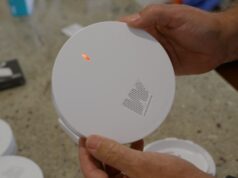
Required by law in Australia, smoke alarms are designed to detect when there’s smoke in your house to help prevent fires. Find out how they work and where they need to be installed.

Smoke alarms are designed to detect smoke, and let off a loud, shrill alarm when it’s detected. The idea behind smoke alarms is to give you early warning of a fire in your home, allowing you to deal with the problem or escape before anyone gets hurt.
What does the law say about smoke alarms?
Smoke detectors are mandatory in all Australian States and Territories. Smoke alarms must be built to conform to Australian Standard AS 3786-1993, as required by the Building Regulations 1994 (the Regulations). All buildings built on or after 1st August 1997 are required to have a smoke alarm that’s both wired into mains power, and supported by a battery backup. Older houses are permitted to have smoke alarms that are operated only by batteries.
Smoke alarms need to be installed by a licensed electrician. Batteries should typically be changed at least once a year – smoke alarms give off a beeping noise when batteries are low.
Where to position smoke alarms
How many you need and where they need to be positioned will depend largely on the layout of your house. Generally speaking, they need to be positioned near bedrooms. If you house has multiple storeys, you will need at least one on every floor of your house. Likewise, if your bedrooms aren’t all in the same part of the house, you will need to install extra smoke detectors wherever bedrooms are located.
How do smoke alarms work?
There are sophisticated optical smoke detectors more suitable to ‘professional’ protection of theatres, sports facilities, etc – usually backed up by building emergency power supplies – and there the domestic ones, which are considerably basic, but very effective for home use.
They are the ionisation type, using a radioactive isotope, americium 241. A very small amount of radioactivity is used and is not dangerous if left in place. You can replace the battery in a smoke alarm, but you should never try to disassemble the detector.
The detector works through smoke interrupting a very low current. The radioactive source emits charged particles – alpha particles – and they make up the small electrical current. Smoke particles absorb this radiation – which causes the current to drop. A circuit detects this drop in current, which activates a shrill buzzer warning you of a possible danger.
How often should I test or replace my smoke alarm?
Ideally, you should test your smoke alarms once per month to ensure that they’re working properly. You can do this by pressing the TEST button on the alarm – it should temporarily emit a loud, high-pitched sound.
To ensure that you’ve always got a fresh battery, you should replace the batteries in your smoke alarms at least once a year – preferably once every six months -even if they haven’t run down. Smoke alarms also have an ‘expected service life’ – they’re made to be used for a set amount of time, after which they should ideally be replaced with new ones. Most manufacturers recommend replacing your smoke alarms after they’ve been in use for 10 years.





